If you’re considering a career as a dog trainer, you may be wondering how much you can expect to earn. While there is no one-size-fits-all answer to this question, understanding the average salary range for dog trainers can help you set realistic expectations and make informed career decisions. In this section, we’ll explore the factors that influence a dog trainer’s income and provide insights into monthly earnings.
- The monthly income of a dog trainer varies based on factors such as experience, location, and specialization.
- Average pay for dog trainers can range from entry-level wages to mid-level salaries and experienced trainer earnings.
- Educational and certification requirements can impact a dog trainer’s earning potential.
- Self-employment and freelance work can offer additional earning opportunities but can also present challenges.
- Negotiation and career growth strategies can help maximize a dog trainer’s earning potential.
Understanding Dog Trainer Salaries
As with any career, the amount of money dog trainers can earn varies depending on several factors. Factors such as experience, location, specialization, and education all impact how much a dog trainer can make on a monthly basis.
According to the Bureau of Labor Statistics, the average pay for animal trainers, including dog trainers, is $35,160 per year, which equates to around $2,930 a month. However, entry-level trainers starting out in the industry can expect to earn less, while those with extensive experience and advanced certifications can earn significantly more.
The average pay range for dog trainers is between $20,000 and $60,000 per year. However, trainers who work for themselves or as freelancers can earn significantly more or less depending on their client base and the services they offer.
To better understand how much you can earn as a dog trainer, it’s essential to dive deeper into the factors that impact your salary. With this knowledge, you can make informed decisions about your career path and explore opportunities for increasing your earning potential.

Dog trainers’ income varies depending on various factors in the industry, such as experience, certifications, location, and specialization. Understanding these variables can help dog trainers earn more and excel in their careers. In this section, we will explore the different factors that influence the income of professional dog trainers and how each of them impacts their earnings.
Certifications
Certifications in dog training can have a significant impact on a trainer’s income. Certified trainers usually earn more than those without certifications. For instance, a Certified Professional Dog Trainer (CPDT) can earn up to $80,000 annually, while a non-certified trainer earns around $40,000. Having certifications like the CPDT indicates that a trainer possesses a high level of knowledge and skill in the industry and is committed to ongoing professional development.
Experience
Experience is another critical factor that influences a dog trainer’s income. Typically, entry-level trainers earn less than those with years of experience. The more years of experience a trainer has, the higher the earning potential. Dog trainers who have worked with various breeds and temperaments and have a proven track record of success can command higher pay rates.
Location
Location is a significant factor that affects dog trainer salaries. The cost of living varies from state to state and city to city, and that can determine the income of professional dog trainers. For example, dog trainers located in major cities or affluent areas can earn more than those in rural or low-income areas. In the United States, dog trainers in states like New York and California earn more than trainers in states like Iowa or Kansas.
Specializations
The type of dog training specialty can also impact a trainer’s earnings. Specializations like therapy dog training and behavioral modification tend to pay higher than general obedience training. For instance, a canine instructor specializing in therapy dog training can earn up to $100 per hour, while a general dog obedience trainer may earn $50 per hour.
Continuing Education
Continuing education and advanced training programs can enhance a dog trainer’s skills and improve earning potential. Trainers with advanced training techniques and qualifications tend to earn more than those with basic training qualifications. Additionally, attending workshops, seminars, and industry conferences can enhance trainers’ knowledge and skill, increasing their earning potential.

The income of professional dog trainers can vary significantly, depending on their experience, certifications, location, specialization, and continuing education. Aspiring dog trainers should invest in their education and seek opportunities to enhance their skills and knowledge to maximize their earning potential.
Education and Certification for Dog Trainers
Education and certification play a crucial role in determining a dog trainer’s salary. Professional trainers with advanced degrees and certifications can command higher wages and have more opportunities for career advancement. On the other hand, trainers with minimal education and no certifications may find it challenging to attract clients and earn a competitive income.
To become a professional dog trainer, a minimum of a high school diploma or GED is typically required. However, pursuing higher education can provide a competitive edge. Degrees in animal behavior, psychology, or a related field can be especially advantageous.
Aside from formal education, there are various certifications available that can enhance a trainer’s credibility and earning potential. For example, becoming a Certified Professional Dog Trainer (CPDT) through the Certification Council for Professional Dog Trainers can demonstrate a trainer’s commitment to quality and ethics in their work. The International Association of Canine Professionals (IACP) also offers various certification programs for dog trainers, including the Certified Dog Trainer certification and the Certified Canine Behaviorist program.
While certifications are not required by law, they can significantly impact a trainer’s earning potential. According to the Bureau of Labor Statistics, the median annual wage for animal trainers, including dog trainers, was $31,520 as of May 2020. However, those with professional certifications and specialized skills can earn significantly more.
For example, the average salary for a canine instructor with a CPDT-KA (Certified Professional Dog Trainer-Knowledge Assessed) certification is $42,000 per year, according to PayScale. Additionally, a dog obedience trainer with specialized skills in behavioral modification can earn an average of $45,000 per year, according to Salary.com.
Overall, pursuing education and certifications in the dog training industry can have a significant impact on a trainer’s earning potential. By demonstrating a commitment to quality and professionalism, trainers can increase their credibility, attract more clients, and ultimately command higher wages.
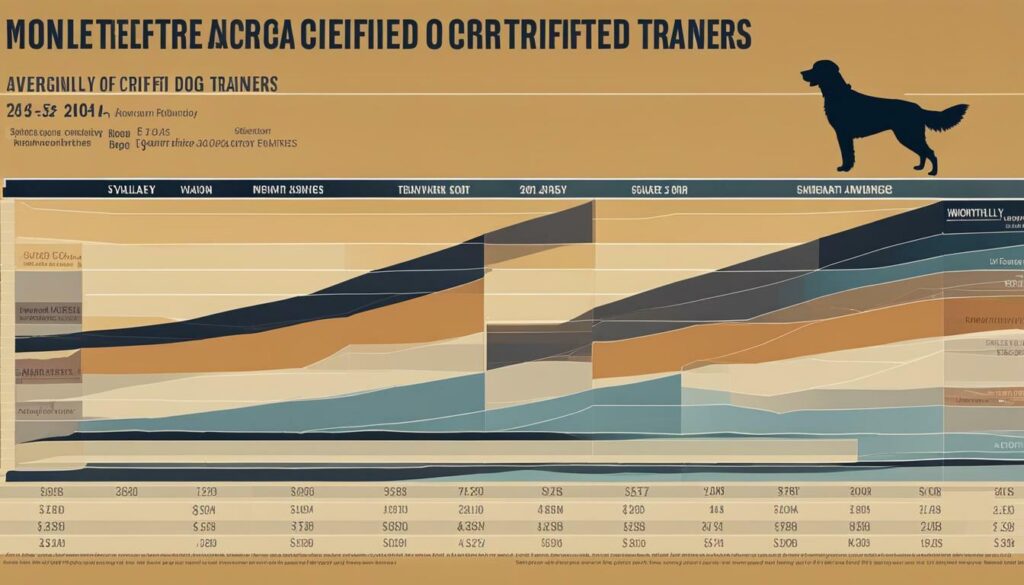
When it comes to determining the average pay for dog trainers, numerous elements come into play, like experience level, geography, specialization, and certifications. According to the data collected by the Bureau of Labor Statistics, the median pay for animal trainers was $30,430 per year in 2020, with the lowest 10 percent earning less than $19,610 and the top 10 percent earning more than $53,580.
In the dog training industry, entry-level trainers with less than a year of experience earn an average hourly wage of $12.28, while mid-level trainers with 1-4 years of experience earn an hourly wage of $14.89. Experienced trainers with over five years of experience can expect to earn an average hourly wage of $17.03.
However, it is crucial to note that these figures are just estimates and do not consider the impact of other variables such as location and specialization, which can influence dog trainer salaries significantly.
To have a more detailed understanding, let’s take a look at the table below:
| Experience Level | Average Hourly Wage (in USD) |
|---|---|
| Entry-Level (0-1 year) | $12.28 |
| Mid-Level (1-4 years) | $14.89 |
| Experienced (5+ years) | $17.03 |
As you can see from the table, experience level significantly impacts dog trainer salaries. Furthermore, advanced specialized courses and certifications can also boost a trainer’s earning potential, providing an avenue for salary growth within the industry.
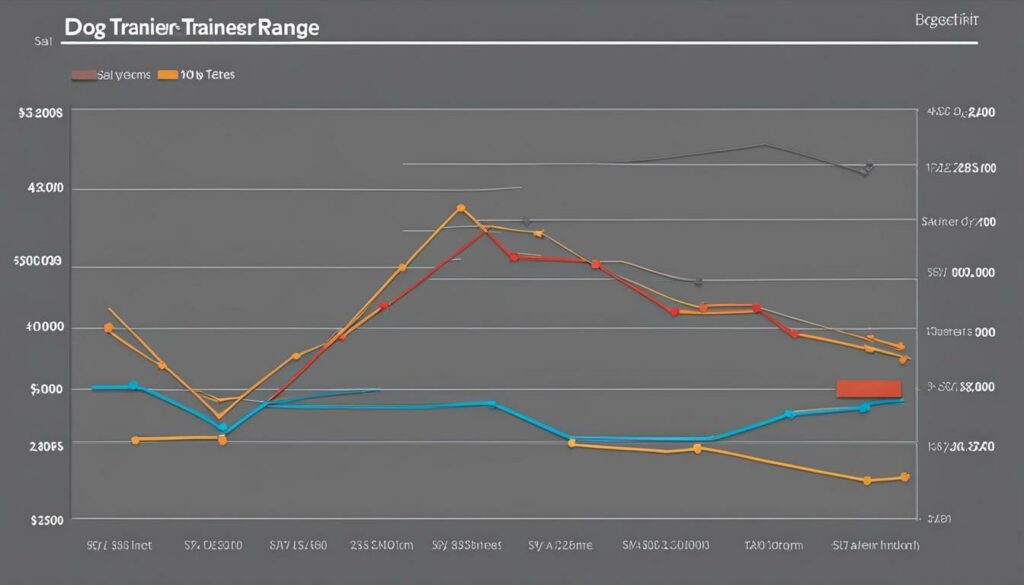
While compensation for dog trainers may not be as high as other professions, individuals who are passionate about dog training and have expertise in the niche can still earn a respectable income. In the next section, we will discuss how location can affect a dog trainer’s salary.
Location and Dog Training Salaries
Location plays a significant role in determining a dog trainer’s income, with regional differences and cost of living impacting earning potential. In areas with a high cost of living, such as San Francisco or New York City, dog trainers may command higher salaries due to the increased demand for their services.
On the other hand, in rural areas or cities with lower average incomes, dog trainer salaries may be lower. Additionally, location influences the types of services that trainers can offer, with specialized services such as therapy dog training being more sought after in some areas than in others.
It’s important to note that while location can impact earning potential, it’s not the sole factor. Trainers with significant experience, specialized skills, and education can earn higher salaries regardless of their location.
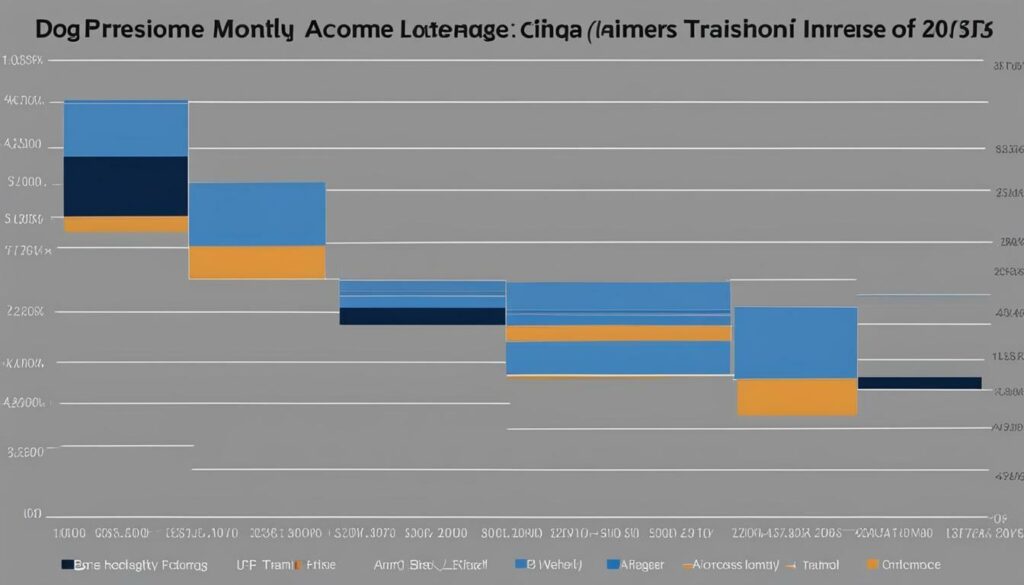
In general, dog trainers can expect to earn between $25,000 and $70,000 per year, but this range can vary widely depending on location and other factors. As such, it’s essential for trainers to research the local market and determine fair rates based on their experience and expertise.
Specializations and Dog Trainer Salaries
Specializing in a particular area of dog training can significantly impact a trainer’s earning potential. The demand for specialized services such as therapy dog training, agility training, and behavioral modification is increasing, and trainers who have expertise in these areas can command higher fees.
Canine instructors who work in specialized fields generally earn higher salaries than those who provide general obedience training. According to industry data, dog trainers who specialize in behavioral modification, for example, earn an average of $64,000 per year, while those who specialize in agility training earn an average of $56,000.
However, it’s important to note that obtaining specialized certification or training can be more time-consuming and expensive than obtaining general obedience training certification. It’s essential to weigh the cost of obtaining specialized credentials against the potential earning benefits.
Beyond these specific specializations, dog trainers with broader knowledge and skills can also earn higher salaries. For example, trainers who have experience with multiple breeds or types of training, such as basic obedience, agility, and therapy dog training, may have more opportunities to earn higher salaries.
Ultimately, the earning potential for a dog trainer specializing in a particular area depends on the demand for their services and how much clients are willing to pay to obtain those services. It’s important to stay up-to-date on industry trends and tailor services to meet evolving client needs to maximize earning potential.
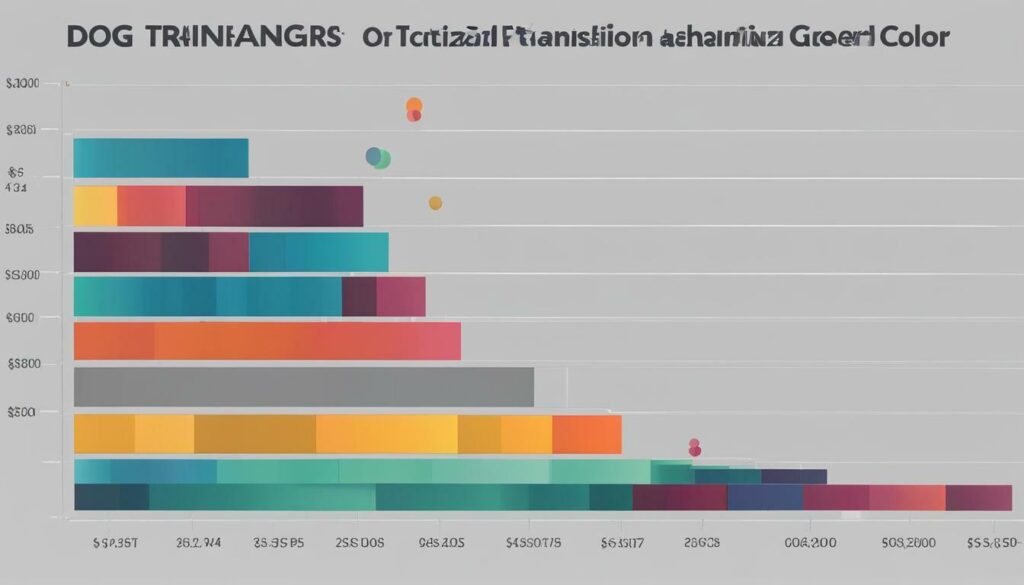
Advanced training techniques can significantly impact a dog trainer’s earning potential. By developing specialized skills and knowledge, trainers can increase their value to clients and demand higher wages.
Whether you are interested in canine sports, behavioral modification, or therapy dog training, advancing your training techniques can lead to increased income as a professional dog trainer.
For example, a dog obedience trainer who specializes in aggressive behavior modification may earn more than those who focus solely on basic obedience training. Similarly, a canine instructor who has experience in therapy dog training may receive higher compensation than those who do not.
Continuing education and specialized training programs are excellent ways to improve your skills and advance in the industry. These programs can include workshops, seminars, or certifications that demonstrate your expertise in a particular area.
With advanced training techniques, you can become a top-tier dog trainer, which can lead to higher wages, increased demand, and more fulfilling work.

| Advanced Training Techniques | Monthly Income of Professional Dog Trainers |
|---|---|
| Agility Training | $2,500 – $5,000 |
| Behavioral Modification | $3,000 – $6,500 |
| Therapy Dog Training | $4,000 – $8,000 |
| Canine Sports Training | $5,000 – $10,000 |
Table: Advanced Training Techniques and Estimated Monthly Income for Professional Dog Trainers
According to the table, specialized training techniques can earn a dog trainer a significantly higher monthly income than general dog training services. By focusing on a specific niche, you can become an expert and earn higher pay rates.
Self-Employment and Freelancing as a Dog Trainer
If you’re looking for more control over your income as a dog trainer, self-employment or freelancing can be an attractive option. As a self-employed dog trainer, you would have the freedom to set your own rates and schedule. You’ll also be responsible for finding your own clients and managing your business. Freelancing offers a similar level of autonomy but without the additional responsibility of managing a business.
Working for yourself as a dog trainer can provide you with greater earning potential, but it can also come with some challenges. As your own boss, you’ll need to be self-motivated and disciplined to ensure a steady stream of clients and income. It’s also essential to have strong marketing skills to promote your services and build a trusted brand.
However, if you are successful in establishing yourself as a reputable and skilled dog trainer, you can earn a substantial income. The monthly income of dog trainers who are self-employed or freelancing can range from $3,000 to $15,000 or more, depending on the number of clients and services you provide.

Keep in mind that being a self-employed dog trainer may not be the best fit for everyone. It’s critical to weigh the risks and benefits before deciding to make the transition from an employee to a business owner. However, if you’re ready to take the leap and build your own successful dog training business, the earning potential can be significant.
Negotiating Salaries and Earning Potential
As a dog trainer, negotiating your salary can be an important aspect of maximizing your earning potential. Whether you are just starting out in the industry or have years of experience, it is essential to understand your worth and advocate for fair compensation.
One strategy for negotiating your salary is to gather information and research average pay for dog trainers in your area. This can help you establish a baseline for what is considered standard compensation and provide leverage when discussing salary with potential employers or clients.
Another approach is to highlight your unique skills and experience to justify a higher salary. For example, if you specialize in a particular type of training or have advanced certifications, you can make a case for why you should be compensated at a higher rate.
It is also important to consider other factors beyond just base salary, such as opportunities for commission or bonuses, benefits packages, and flexible scheduling. By taking a holistic approach to evaluating potential compensation, you can ensure that you are receiving fair pay and other perks that are valuable to you.
Additionally, it is important to continue to invest in your education and skills to increase your earning potential over time. By staying up-to-date on the latest training techniques and obtaining advanced certifications or degrees, you can position yourself as a top-tier dog trainer with a higher earning capacity.

Overall, understanding your worth and advocating for fair compensation is essential for maximizing your earning potential as a dog trainer. By taking a strategic approach to negotiating your salary, investing in your education, and considering other aspects of compensation beyond just base pay, you can position yourself for long-term success and growth within the industry.
Benefits and Perks in the Dog Training Industry
Beyond the monthly income, the dog training industry offers various benefits and perks that can make the job rewarding and fulfilling. One of the most significant benefits is the ability to work with animals and contribute to their well-being. Many trainers find this aspect of their job personally fulfilling and enjoy the opportunity to make a positive impact on dogs and their owners.
Another perk of working in the dog training industry is the potential for flexible schedules. Many trainers work for themselves or as freelancers, which allows them to set their own hours and take on as many clients as they desire. This can be especially advantageous for those who have other obligations, such as family or personal commitments.
In addition to flexibility and working with animals, the dog training industry also provides opportunities for personal and professional growth. Trainers can attend conferences, workshops, and certification programs to develop their skills and expand their knowledge. As a result, they can increase their earning potential and become more in-demand within the industry.
Finally, the dog training industry can provide a strong sense of community among trainers and enthusiasts. Many trainers find that they are part of a close-knit community of professionals who share a love for dogs and a commitment to their training and well-being. This sense of camaraderie can make the job more rewarding and meaningful.

Overall, the dog training industry offers more than just a steady income. It provides a range of benefits and perks that can make the job fulfilling and rewarding. From working with animals and setting flexible schedules to opportunities for personal and professional growth, the industry has much to offer for those who love dogs and are committed to their training and well-being.
Advancement Opportunities for Dog Trainers
Becoming a professional dog trainer provides a variety of advancement opportunities that can increase earning potential. As a dog trainer gains experience and expertise, they may have the opportunity to specialize in a particular area such as therapy dog training or behavioral modification. This specialization allows trainers to market themselves as experts in their field and potentially earn higher wages.
Another advancement opportunity for dog trainers is to become a canine instructor or dog obedience trainer. These positions typically require additional education and certification, but the higher level of expertise can lead to increased earning potential. Dog obedience trainers can earn higher wages by training dogs for complex tasks such as search and rescue or law enforcement work.
Trainers who seek career advancement can also consider transitioning into a leadership role within their organization. Opportunities may exist to become a lead trainer or manage a team of trainers, which can come with additional compensation and benefits. Additionally, self-employment or freelance work can provide opportunities for trainers to increase their income and gain more flexibility and control over their schedule.
In summary, the dog training industry offers a variety of advancement opportunities for professionals looking to increase their earning potential. Whether through specialization, additional education and certification, or leadership roles, dog trainers can potentially earn higher wages and enjoy a more fulfilling career.
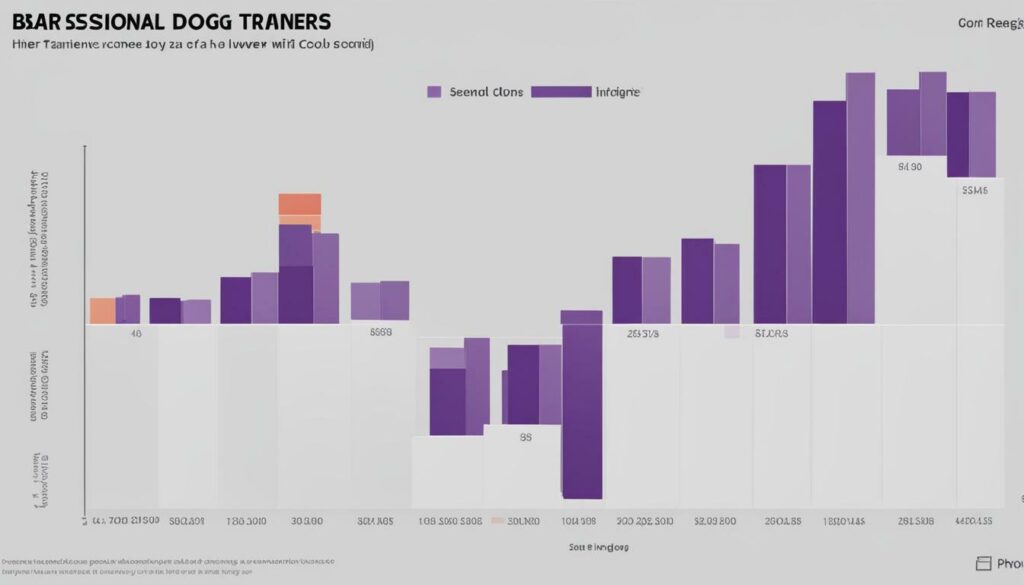
According to the Bureau of Labor Statistics, the median annual wage for animal trainers, including dog trainers, was $33,600 in May 2020. However, this does not provide a clear picture of the monthly income of dog trainers, which can vary widely depending on experience, qualifications, location, and other factors.
Entry-level dog trainers with limited experience typically earn around $15,000 to $20,000 per year, which translates to a monthly income of $1,250 to $1,666. Mid-level trainers with more experience and education can earn around $30,000 to $50,000 per year, which works out to a monthly income of $2,500 to $4,166.
Experienced dog trainers with a strong reputation and specialized skills can earn significantly more. For example, professional dog trainers who work with celebrities, high-profile clients, or large corporations can earn upwards of $100,000 per year, equating to a monthly income of $8,333.
| Experience Level | Average Annual Salary | Monthly Income |
|---|---|---|
| Entry-level | $15,000 to $20,000 | $1,250 to $1,666 |
| Mid-level | $30,000 to $50,000 | $2,500 to $4,166 |
| Experienced | $50,000 to $100,000+ | $4,166 to $8,333+ |
It’s important to note that these figures are only estimates and may vary depending on various factors such as the individual trainer’s specialization, location, client base, and negotiation skills.
For example, in some areas, dog trainers may charge higher rates due to the cost of living or demand for their services. Additionally, trainers who offer specialized services such as therapy dog training or aggression rehabilitation may command higher fees due to their specialized skills and expertise.
Ultimately, how much a dog trainer makes a month will depend on various factors, but with passion, hard work, and a commitment to ongoing education and training, dog trainers can potentially earn a comfortable income while doing what they love.
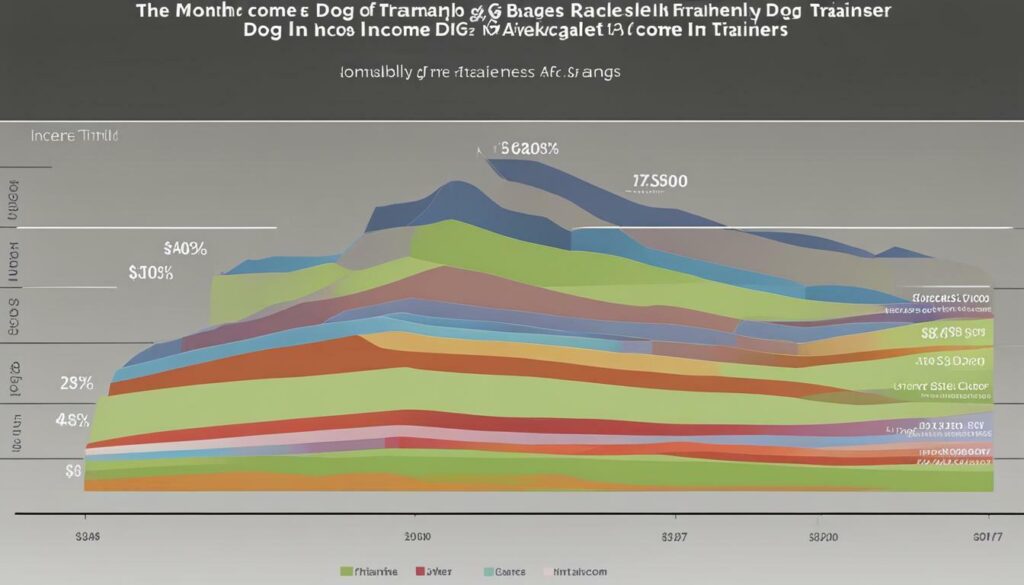
As a dog trainer, increasing your income doesn’t have to be a daunting task. Below are some practical tips and strategies that you can use to grow your client base and diversify your services.
1. Network with Other Professionals
One effective way to increase your income as a dog trainer is to network with other pet professionals in your area. Veterinarians, groomers, and pet store owners can be valuable connections that can refer clients to you.
Consider attending industry events or joining local pet-related organizations to expand your network and make new connections.
2. Expand Your Services
Offering additional services can also help you increase your income as a dog trainer. Consider expanding your services to include pet sitting, dog walking, or boarding.
By offering a wider range of services, you can attract more clients and generate more income.
3. Specialize in a Niche Area
Specializing in a niche area of dog training can also help you increase your earning potential. Whether it’s training therapy dogs or teaching agility classes, focusing on a specific area can set you apart from your competition and attract clients who are looking for specialized services.
4. Increase Your Rates
As your experience and qualifications grow, consider increasing your rates. Don’t be afraid to charge what you’re worth and communicate the value of your services to clients.
Remember, clients are willing to pay for quality services, and increasing your rates can help you attract higher-paying clients and increase your income.
5. Market Yourself Effectively
Effective marketing can also help you increase your income as a dog trainer. Utilize social media platforms, create a professional website, and consider running targeted online ads to promote your services.
Make sure to highlight your qualifications and experience in your marketing materials, and showcase any positive client feedback you’ve received.
By applying these tips, you can increase your income as a dog trainer and achieve greater success in the industry. With dedication and hard work, you can reach your earning potential and enjoy a fulfilling career working with our furry friends.

After exploring the intricacies of the dog training industry and factors that impact salaries, it is clear that the income potential for dog trainers can vary greatly. On average, a dog trainer can expect to earn a monthly income of around $2,500 to $3,500.
Factors such as education, certification, experience, location, specialization, and advanced training techniques all play a role in determining a dog trainer’s earning potential. Freelancing and self-employment can also impact income potential. Negotiating salaries and advocating for fair compensation are essential in maximizing earning potential.
Despite the fluctuations in salary, there are many additional benefits and perks to being a dog trainer beyond income. These include flexible schedules, working with animals, and personal fulfillment. And for those looking for advancement opportunities, there are several paths for growth within the industry.
Overall, the dog training industry can provide a fulfilling and financially rewarding career for those willing to put in the effort. By continuing education, specializing in certain areas, and expanding services, dog trainers can increase their income potential and make a significant impact in the lives of both dogs and their owners.
FAQ
Q: How much does a dog trainer make a month?
A: The monthly income of a dog trainer can vary depending on various factors such as experience, location, and specialization.
Q: What is the average pay for dog trainers?
A: The average pay for dog trainers can range from $30,000 to $50,000 per year.
Q: What factors influence dog trainer salaries?
A: There are several factors that can influence dog trainer salaries, including experience, certifications, location, and specialization.
Q: What education and certification are required for dog trainers?
A: While formal education is not always required, many dog trainers choose to pursue certifications from reputable organizations to enhance their skills and credibility.
Q: What is the average salary range for dog trainers?
A: The average salary range for dog trainers can vary depending on experience and qualifications, with entry-level trainers earning around $20,000 to $30,000 per year, mid-level trainers earning $30,000 to $50,000 per year, and experienced trainers earning $50,000 or more per year.
Q: How does location impact dog trainer salaries?
A: Location plays a significant role in determining a dog trainer’s salary, as different regions may have varying demand and cost of living.
Q: How do specializations affect dog trainer salaries?
A: Specializations within the dog training field, such as therapy dog training, agility training, and behavioral modification, can impact a trainer’s earning potential.
Q: Do advanced training techniques impact dog trainer salaries?
A: Advanced training techniques can enhance a dog trainer’s skills and expertise, potentially leading to higher earning potential.
Q: Can dog trainers be self-employed or work as freelancers?
A: Yes, many dog trainers choose to be self-employed or work as freelancers, allowing them to have more control over their income potential.
Q: How can dog trainers negotiate their salaries?
A: Dog trainers can negotiate their salaries by showcasing their skills and experience, highlighting their unique value proposition, and advocating for fair compensation.
Q: What are the benefits and perks in the dog training industry?
A: In addition to income, dog trainers may enjoy benefits such as flexible schedules, the opportunity to work with animals, and personal fulfillment.
Q: What are the advancement opportunities for dog trainers?
A: Dog trainers can explore advancement opportunities within the industry, such as becoming a head trainer, starting their own training facility, or specializing in a specific area.
Q: Can you provide real-life examples of dog trainer salaries?
A: While specific salaries may vary, real-life examples can provide insights into the earning potential of dog trainers. Case studies and examples can illustrate different income levels within the industry.
Q: What are some tips for increasing dog trainer income?
A: Dog trainers can increase their income by expanding their client base, offering additional services, diversifying their training methods, and continuously improving their skills.
Q: Conclusion
Summarize the key points discussed in the article and highlight the potential earnings of dog trainers. Conclude with a final perspective on the dog training industry and its income opportunities.

Marissa Delotta, 36, from Dayton, Ohio, is the creative force behind Roverboard.com, a beloved online destination for dog lovers. As a dedicated mom and canine enthusiast, Marissa combines her family experiences with her love for dogs to offer a platform where dog owners can exchange tips, heartwarming stories, and advice. Her website has become a vibrant community for sharing the joys of dog parenting. In her free time, Marissa enjoys exploring dog parks with her family and volunteering at local animal shelters.